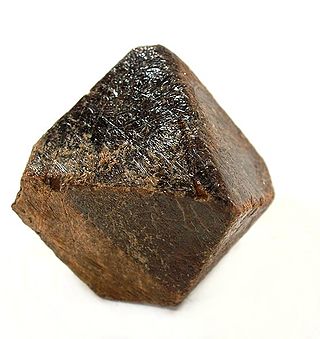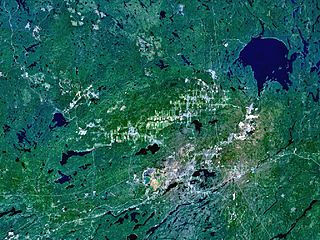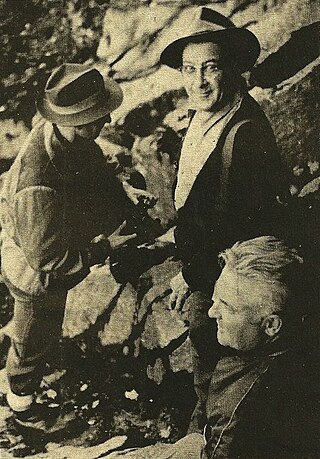
Uraninite, formerly pitchblende, is a radioactive, uranium-rich mineral and ore with a chemical composition that is largely UO2 but because of oxidation typically contains variable proportions of U3O8. Radioactive decay of the uranium causes the mineral to contain oxides of lead and trace amounts of helium. It may also contain thorium and rare-earth elements.

Pyrochlore2Nb2O6(OH,F) is a mineral group of the niobium end member of the pyrochlore supergroup. The general formula, A2B2O7, represent a family of phases isostructural to the mineral pyrochlore. Pyrochlores are an important class of materials in diverse technological applications such as luminescence, ionic conductivity, nuclear waste immobilization, high temperature thermal barrier coatings, automobile exhaust gas control, catalysts, solid oxide fuel cell, ionic/electrical conductors etc.

The Sudbury Basin, also known as Sudbury Structure or the Sudbury Nickel Irruptive, is a major geological structure in Ontario, Canada. It is the third-largest known impact crater or astrobleme on Earth, as well as one of the oldest. The crater was formed 1.849 billion years ago in the Paleoproterozoic era.

Thorite, (Th,U)SiO4, is a rare nesosilicate of thorium that crystallizes in the tetragonal system and is isomorphous with zircon and hafnon. It is the most common mineral of thorium and is nearly always strongly radioactive. It was named in 1829 to reflect its thorium content. Thorite was discovered in 1828 on the island of Løvøya, Norway, by the vicar and mineralogist, Hans Morten Thrane Esmark, who sent the first specimens of this black mineral to his father, Jens Esmark, who was a professor of mineralogy and geology.

The Spruce Pine Mining District is a swath of the valley of the North Toe River in the Blue Ridge Mountains of northwestern North Carolina. The area is mined for its mica, kaolin, quartz and feldspar. Spruce Pine district is one of the largest suppliers of high-purity quartz, which is used in the manufacture of silicon chips. The district is named after the town of Spruce Pine, which is located in the middle of the region and is the hub of major mining activity there. The district is approximately 25 miles long and 5 miles wide.

Uranium ore deposits are economically recoverable concentrations of uranium within the Earth's crust. Uranium is one of the more common elements in the Earth's crust, being 40 times more common than silver and 500 times more common than gold. It can be found almost everywhere in rock, soil, rivers, and oceans. The challenge for commercial uranium extraction is to find those areas where the concentrations are adequate to form an economically viable deposit. The primary use for uranium obtained from mining is in fuel for nuclear reactors.

Madawaska Mine (previously known as Faraday Mine) is a decommissioned underground uranium mine in Faraday, near the town of Bancroft, Ontario, which produced 9 million pounds (4,082 tonnes) of U3O8 concentrate, at an average ore grade of 0.1074%, during its two periods of production.

Faraday is a township in the Canadian province of Ontario, located within Hastings County adjacent to the town of Bancroft.

Betafite is a mineral group in the pyrochlore supergroup, with the chemical formula (Ca,U)2(Ti,Nb,Ta)2O6(OH). Betafite typically occurs as a primary mineral in granite pegmatites, rarely in carbonatites. Originally defined by the B-site atom Ti, the development of new nomenclature for mineral names led to modernization of the system for nomenclature of pyrochlore and betafite in order to further rationalize the naming process of this grouping of minerals. Only two of the mineral species that were formerly recognized as betafite are presently retained. They are oxyuranobetafite and oxycalciobetafite. The term betafite is now a synonym or varietal group name under the pyrochlore super group.

For many years, North America was the largest exporter of uranium ore in the world and has been a major world producer since demand for uranium developed. In 2009 Kazakhstan took over top spot, relegating Canada to second. 20% of the world's primary uranium production came from mines in Canada in 2009. 14.5% of the world production came from one mine, McArthur River. Currently the only producing area in Canada is northern Saskatchewan, although other areas have had active mines in the past.
The geology of Niger comprises very ancient igneous and metamorphic crystalline basement rocks in the west, more than 2.2 billion years old formed in the late Archean and Proterozoic eons of the Precambrian. The Volta Basin, Air Massif and the Iullemeden Basin began to form in the Neoproterozoic and Paleozoic, along with numerous ring complexes, as the region experienced events such as glaciation and the Pan-African orogeny. Today, Niger has extensive mineral resources due to complex mineralization and laterite weathering including uranium, molybdenum, iron, coal, silver, nickel, cobalt and other resources.

The Siilinjärvi carbonatite complex is located in central Finland close to the city of Kuopio. It is named after the nearby village of Siilinjärvi, located approximately 5 km west of the southern extension of the complex. Siilinjärvi is the second largest carbonatite complex in Finland after the Sokli formation, and one of the oldest carbonatites on Earth at 2610±4 Ma. The carbonatite complex consists of a roughly 16 km long steeply dipping lenticular body surrounded by granite gneiss. The maximum width of the body is 1.5 km and the surface area is 14.7 km2. The complex was discovered in 1950 by the Geological Survey of Finland with help of local mineral collectors. The exploration drilling began in 1958 by Lohjan Kalkkitehdas Oy. Typpi Oy continued drilling between years 1964 and 1967, and Apatiitti Oy drilled from 1967 to 1968. After the drillings, the laboratory and pilot plant work were made. The mine was opened by Kemira Oyj in 1979 as an open pit. The operation was sold to Yara in 2007.

Dyno Mine is a decommissioned underground uranium mine located at Cardiff, near Farrel Lake, approximately 30km southwest of Bancroft, Ontario. It operated from 1958 to 1960.

Greyhawk Mine is a decommissioned underground uranium mine located in Faraday Township near Bancroft, Ontario. It operated from 1954 to 1959 and from 1976 to 1982. The mine produced 80,247 tons of uranium ore, of which 0.069% was U3O8 worth $834,899.

Uranium mining in Bancroft represents one of two major uranium-producing areas in Ontario, and one of seven in Canada, all located along the edge of the Canadian Shield. In the context of mining, the "Bancroft area" includes Haliburton, Hastings, and Renfrew counties, and all areas between Minden and Lake Clear. Activity in the mid-1950s was described by engineer A. S. Bayne in a 1977 report as the "greatest uranium prospecting rush in the world". Mining activities were conducted during two periods, 1956–1964 and 1975–1982, when uranium prices made underground hard-rock mining of the ores economically viable.

Arthur H. Shore was a mineral prospector and the first person set up a uranium mine in Faraday Township, Ontario. He co-founded and managed the Reeves feldspar Mine and founded the Faraday Uranium Mine. His uranium prospecting, according to Bayne in 1977, led to the "greatest uranium prospecting rush in the world."
Princess Sodalite Mine is a sodalite quarry and retail shop, located near Bancroft, Ontario. The sodalite deposit was first discovered in 1892.
The Fission Mine, previously known as the Richardson Deposit, is a flouride and uranium deposit in Cardiff, near Wilberforce, Ontario, Canada.

Cardiff is a community in Highlands East, Ontario. It was incorporated in 1862, and became a uranium mining town during the late 1950's.




















